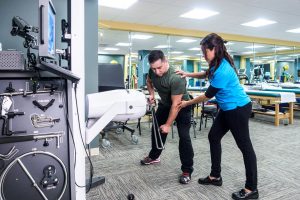
The Psychological Impact of Functional Rehabilitation
Treatment Guidelines
As mental health gains increasing recognition, understanding the psychological aspect of recovery is more important than ever. Learn why I consider the first failure a major milestone, how to leverage the therapeutic alliance, and the impact on three clinical settings: neurologic, workers' comp, and geriatric.
Functional rehabilitation represents a revolution in our industry. Transcending traditional boundaries in physical therapy and occupational therapy, it is a comprehensive approach to recovery. With its focus on restoring daily activities and independence, functional rehab engages the body as well as the mind.
That’s where functional rehabilitation has an edge over other philosophies – its psychological impact. In a world where mental health is gaining increasing recognition, understanding the psychological aspect of recovery is more important than ever.
In this article, we’ll discuss the psychological impact of functional rehabilitation. You’ll learn why I consider the patient’s first failure a major milestone, how your relationships influence clinical outcomes, and the impact of visualization. We’ll also cover why and how to document progress objectively with innovative tools to help you do so. Finally, an exploration of functional rehabilitation in three important clinical settings: workers’ compensation, neurologic conditions, and geriatric care. Let’s dive in!
History of Functional Rehabilitation
The rudimentary beginnings of rehabilitation appear in texts from Greek, Roman, and ancient Chinese cultures.1 The first inkling of functional rehabilitation comes from the 18th-century text Medical and Surgical Gymnastics.1 This text describes the benefit of movement for patients recovering from neurological incidents such as strokes.
R. Tait McKenzie developed rehabilitation practices further. He was a physical educator, Physician, Physical Therapist, and author of Reclaiming the Maimed: A Handbook of Physical Therapy.2 This handbook describes specific ways to improve function and was the official reference for hospital rehabilitation for Americans, Canadians, and the British during WWI.2
Functional rehabilitation became more distinct during the occupational therapy movement in the early 1900s.3 Stemming from the mental health sector, early OTs assisted sanitorium patients with industrial work tasks throughout the day. This structure provided a sense of worth for their patients.
In WWII, functional rehabilitation practices used by therapists were further recognized by the U.S. Military.2 Wounded soldiers had such a marked increase in productivity after working with OTs that Canadian and British militaries both allowed therapists on the front lines.3 The value of functional rehabilitation in the healthcare space has only compounded from here.
What Makes Rehabilitation Functional?
Functional rehabilitation focuses on exercises and movements that directly translate to a functional skill. Instead of addressing specific muscle groups involved in the skill, the skill itself is the intervention.
Since WWII, functional rehab has gained popularity across the healthcare sector and is used almost daily by us therapists. Regardless of discipline, the functional component to these interventions allows rehabilitation progress to hold more weight, meaning, and purpose for patients.
Psychological Considerations During Treatment
As we all know, the road to recovery takes time, patience, and trust. Rehabilitation encompasses much more than just the physical restoration of muscles, joints, or neurological systems. In fact, physical rehabilitation is only half of the rehab journey. The psychological aspect carries just as much weight in the process of recovery.
A good level of self-efficacy is imperative to a successful rehab journey.4 Low self-efficacy can too easily lead to learned helplessness and lower motivation to do things independently. For many patients, psychological hurdles include the fear of pain, anxiety about reinjury, lack of trust in their body, fear of falling, and more. Even a temporary loss of an activity due to injury can lead to disappointment, anger, social isolation, and even .5
Once treatment begins, we can expect to see some patients regain their optimism. Their emotional state will likely fluctuate as they experience victories and setbacks during the course of treatment. In my experience, one milestone stands out as a significant learning experience for patients.

Subscribe to receive email updates from TherapySpark.
The First Failure
As an OT on an inpatient rehabilitation spinal cord unit, I have witnessed firsthand the emotional rollercoaster of recovery. Recovering from life-altering injuries and relearning daily functions is nothing short of daunting. For the patient, every little action feels different. Body parts operate differently, and even sitting up in bed can feel like an out-of-body experience much of the time.
Relearning a skill that once came naturally is something you can’t comprehend until you’ve experienced it. The first time a patient fails at a skill can feel like a setback, but is actually a major milestone in my eyes. Most people don’t understand what it takes to relearn a skill until that first failure. This first failure essentially alters how they perceive their body and performance ability, which has huge emotional meaning.
That first failure often opens the floodgates to the grieving process, if it hasn’t started already. Grieving the decisions leading up to an activity that caused an injury, grieving the familiarity of a body that no longer exists in the same way, being in a body that is completely different functionally than what you once knew. It alters the perception and experience of the world and triggers a psychological process of patients redefining their role as a person in society again and taking back that autonomy with confidence and support.
While grieving isn’t a pleasant process, it’s necessary for patient success. Once this process starts flowing, the real work can happen and motivation kicks in. Joining patients in the journey of redefining how they want their life to be (with some new considerations like paralysis) is an emotional but invigorating process.
Therapeutic Alliance and Patient Perception
One of the most influential psychological aspects of treatment is your relationship with the patient. This relationship influences the patient’s belief in the efficacy of treatment, which has a real impact on their clinical outcomes.
Successful rehabilitation is defined by how the patient perceives the relevance of therapeutic outcomes.6 These outcomes are often concerning their everyday life or goals and are as unique as patients themselves.6 We learn while earning our degrees that our genuine interactions with patients are a huge influence on this perception.
Therapeutic alliance is a term that encompasses how we, as therapists, build rapport and a positive relationship with patients.7 This relationship has been found to directly correlate to patient engagement, satisfaction, and overall outcomes in a rehab setting.
We’ve seen it firsthand; good rapport is established between us and a patient which leads to the patient engaging more in interventions and sessions. This leads to that patient having more positive functional outcomes and in turn, being more satisfied with their program as a whole.
For example, let’s say a professional chef receives services to recover from a tendon repair surgery after a kitchen accident. Their OT establishes great rapport with the patient and pays attention to the importance of regaining those cooking tasks.
At a certain point in recovery, the OT creates a functional intervention plan, using a set of cooking pans of various weights and grip handles. Over time, working with these tools increases the patient’s grip strength, endurance, functional abilities, and confidence. The patient understands how their performance compares to before their injury. This helps them develop a strong sense of progress and belief in the treatment plan.
The positive physical and psychological results tend to carry over and augment each other. On the flipside, you’ve probably noticed that patients with the best mindset for recovery tend to see better results than those who are reluctant, disengaged, or non-compliant. This underlines the importance of your relationship with the client.
Visualization
One of the major tools of functional rehabilitation is visualization. When used in rehab, visualization is imagining a movement or combination of movements while practicing them. Physical and Occupational Therapists use visualization, especially in neurorehabilitation, to encourage patients attempting to restore a particular motor pattern.
The goal of visualization may include normalizing a functional reach pattern or balance skills such as weight shifting. It can also extend to orthopedic recoveries, such as restoring a more typical gait pattern after a hip replacement.
Other visualization techniques are a little more concrete and simulated, which can help with more niche-type tasks. This can also be helpful for us as therapists in seeing what may be firing and misfiring when a patient visualizes and attempts a task in order to address it better.
Measuring Outcomes in Functional Rehab
The psychological benefits of functional rehab aren’t limited to what you do in treatment sessions. You can also make a positive impact by providing concrete feedback on their progress. It’s not always easy to document patient progress, but doing so can provide strong motivation for your patients.
I’m constantly asked by patients “how am I doing?”, and I usually lead with “I don’t sugar coat this…” I’ve found that even if I give a plain-as-day answer, pointing out the progress, it can be hard for a patient to truly believe they’re making progress. Instead of my verbal affirmation, they respond best when I can provide some form of a visual measurement, like a score.
Providing numerical, objective measures is particularly helpful with clinician and patient perceptions of overall success.8 Concrete data shows that the hard work is paying off, helps with documentation, and can fine-tune future goals for each patient. It helps reinforce the connection between treatment exercises and the real-life payoff.
Objective reporting can help even the most difficult patients turn a corner. I’ve found that the patients that struggle most with believing they’re making progress are those that hope to get back to everything they used to do in under a month. These are the ones that benefit the most from objectively measuring functional rehab outcomes. Seeing their score or progress bars grow week by week provides much needed encouragement to keep going.
The Innovation of PrimusRS
The PrimusRS is an innovative piece of equipment that not only provides functional rehabilitation exercises, but documents and reports patient progress with objective data.
This device has a variety of attachments and features, from steering wheels to various handles and an entire database of functional activities programmed to accurately mimic the force, weight, resistance, and lines of pull for nearly any task. By simulating real-life functional activity, patients immediately understand how this device helps them get better, they quickly gain confidence in their tasks, and can improve their technique or mechanics to avoid future injury.
Progress With Objective Data
Value-based therapeutic service is a concept of healthcare that has waxed and waned since the days of Florence Nightingale. Often, therapists are caught between a rock and a hard place by providing accurately simulated and measurable tasks while maintaining productivity standards.
The PrimusRS system efficiently tracks incremental changes and produces graphic reports for each patient. The automated measurement provides concise method to document and report a patient’s progression, plateau, or regression in any particular exercise or task.
The PrimusRS helps bridge the gaps between producing measurable results, practical task function, and patient perception of benefit while being efficient for clinicians to set up and adjust during a session.
The Psychological Benefits of Functional Rehabilitation Across a Spectrum
The functional rehabilitation approach applies to work conditioning and hardening settings, such as with athletes, workers’ compensation claims, and those with neurological injuries.8 By definition, functional rehabilitation is the process of returning a patient to a performance level acceptable for a particular job or task after an injury.
Regardless of what task it’s concerning, simple or complex, functional rehabilitation is integrated into every rehabilitation journey to a degree. It helps motivate individuals to push through difficult humps in the road and serves as a concrete product of a patient’s hard work. Next, we’ll explore the psychological impact of functional rehabilitation in three common settings: work hardening / work conditioning, neurological rehabilitation, and geriatric care.
Work Hardening and Conditioning
Workers’ compensation claims are some of the most finicky that we deal with as clinicians. Often, these are overuse injuries, back injuries, shoulder injuries, etc., that affect a patient’s ability to satisfy a job demand. To return to work, the patient needs documentation that they can perform their duties effectively and safely.
Work hardening varies from work conditioning in subtle ways. Work hardening is a regimented process focused on returning an individual to work successfully. In contrast, work conditioning focuses on a worker’s longevity throughout their career.
Work hardening often includes directly simulated tasks and weights, especially for those in physical professions like construction, firefighters, and factory lines. Specific items such as boxes, lumber, ladders, poles, and tools are commonly integrated into sessions as real-life simulations. This simulation serves as a basis for objective documentation for the company to determine if the employee is fit to return to work.
Navigating rehabilitation in workers’ compensation is difficult enough. It can be even more difficult when battling with the potential of losing a job that’s considered part of your identity. Being able to have concrete, visible progress with familiar tasks can bring the process back down to earth. It gives patients something to hold on to and celebrate.
Neurological Injuries
Neurorehabilitation and neuroplasticity are some of the best representations of functional rehabilitation. One of the core principles of neuroplasticity is that salience matters, meaning the higher the meaning of activity or skill to the patient, the greater the incidence of skill mastery.8
Pair functional rehabilitation tasks with visualization techniques, and soon the gears start turning, motor patterns start to emerge in a more organized way, and the patient directly sees their hard work paying off.
With those experiencing lower motor neuron injury, the brain often remembers the motor pattern, but the body can’t execute it the way the brain is signaling. That’s when visualization can help.
For example, I’ll often have my spinal cord injury patients visualize a functional movement pattern, such as self-feeding, while providing hand-over-hand assistance to execute the pattern as accurately as possible. I’ll tend to pick a favorite food to visualize along with everything; you’d be amazed at how much more effort is put in to eat an imaginary chicken nugget than a piece of therapeutic putty.
For those with injuries to the brain that impact the signal generation itself, I often break down functional steps to a task and then attempt to combine them. I find that the full execution is where the most error and frustration can happen if the individual parts aren’t addressed first. I find this additionally helps with visualizing the complete movement. Sometimes the full motor pattern is too complex for a healing brain at first.
Geriatric Conditions, Including Dementia
Functional rehabilitation has a stark benefit for older adults, especially those experiencing dementia. Aside from working in a hospital, I’ve worked as the primary OT in a skilled nursing facility with memory care, long-term stay, and short-term rehab. Especially with my memory care and long-term rehab, patient refusal was high unless they perceived the task as functional and important.
I’ve found that older adults generally performs better with more concrete tasks than abstract visualization, so the closer the task can be simulated to the real thing, the better. This can extend further into tasks that have been most likely repeated throughout their life. That may look like wiping down the table, folding clothes, raking leaves, sweeping the floor, or tinkering.
In this setting, I had many patients that knew they weren’t leaving the facility, which is an adjustment in and of itself. In light of this, sometimes it was difficult for them to put in real effort in their sessions. I found that using objective measurements significantly helps give concrete meaning to our therapy time.
Make It Functional and Make It Matter
Functional rehabilitation matters to us as clinicians, it matters to the patient, and helps ground the rehabilitation process. Simulating real-life tasks leads to greater patient engagement and better patient outcomes as a whole. It gives a tangible answer to the question I’ve heard many times, “why are we doing this?”
The more a patient feels they are making progress, the more they’ll generally follow our recommendations. In difficult cases, objective data can help tremendously with providing proof of improvement, showing that the patient’s hard work isn’t for nothing.
It’s often time-consuming to simulate every task, job, or hobby from scratch that a patient might have to accomplish. But focusing on the most important tasks is very valuable and is easier with the help of technology. Equipment like the PrimusRS can simulate any real-life task, measure and report objective data, and keep patients motivated to continue treatment.
The psychological impact of functional rehabilitation reaches patients at a different level. Functional rehabilitation bridges a complex process to grounded outcomes and answers the “why” question with concrete results. Paired with great therapists, patients are more engaged and see the benefits of therapy a little more clearly.
Mary Vieregge, OTR/L is an Occupational Therapist and freelance writer based in Eastern North Carolina. She has experience in a range of settings, from inpatient rehabilitation to long-term care, with a concentration in neurorehabilitation and spinal cord injury populations. Mary is passionate about patient education and innovative practices, is constantly searching for the latest and greatest to add to her clinical toolbox, and enjoys connecting over LinkedIn or UpWork.




